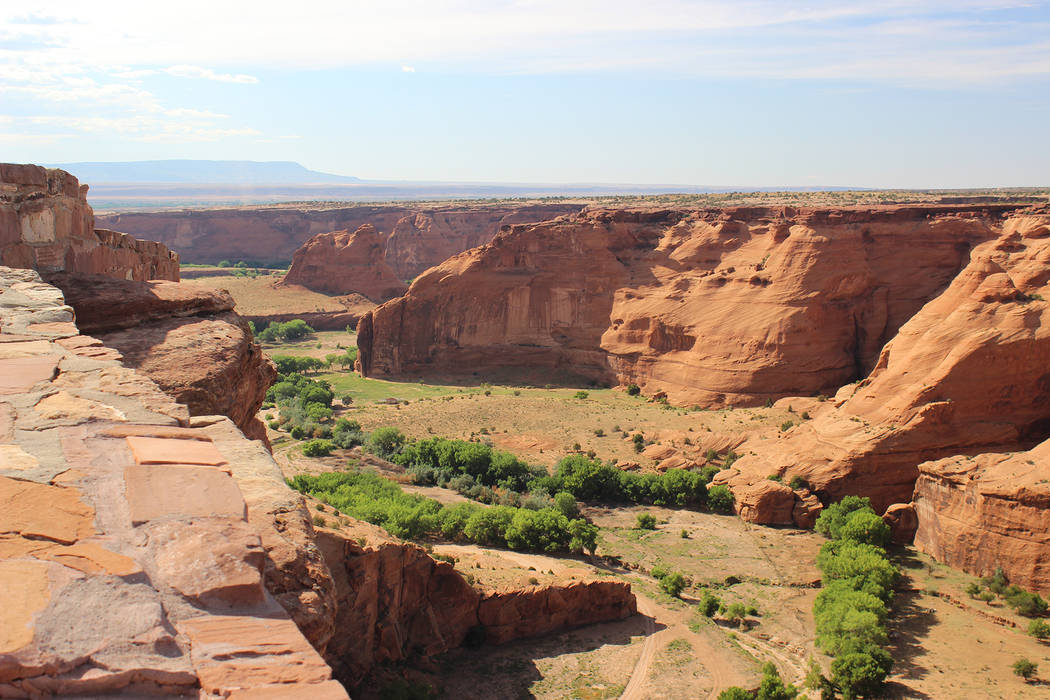
Canyon de Chelly National Monument in Arizona is definitely off the beaten path, but it’s worth the extra time to see its wonders. The monument boasts three main sandstone canyons, Canyon de Chelly (pronounced “de-shay”), Canyon del Muerto and Monument, and are all worth seeing firsthand as they are full of hundreds of archaeological sites including ruins of former dwellings, petroglyphs and pictographs.
In January 1864, Canyon de Chelly was one site of the decisive U.S. operation of the Navajo Wars, in which Col. Kit Carson’s scorched-earth campaign forced the surrender of 8,000 Navajo. In 1868, the Navajo were allowed to return to their homeland.
The park was established in 1931 and encompasses 84,000 acres within the Navajo Reservation in Chinle. Although jointly managed by the National Park Service and the Navajo, it is also home to some of the Dine’ (Navajo) people. The elevations in the park range from 5,500 feet to 7,000, feet so expect temperatures about 15 to 25 degrees lower than in Boulder City.
If you’re just passing through and short on time, you can still visit the overlooks along the 16-mile South Rim and 18-mile North Rim drives, and even hike the one trail visitors are allowed to take down into the canyon. The White House Trail is about 2.5 miles round trip and descends about 600 feet. Here you will find the White House Ruin, where ancestral Puebloans lived around 1,000 years ago.
To see the canyons in-depth, you’ll need to sign up with an approved Navajo guide for a jeep tour. A list of guides is available on the park’s website, https://www.nps.gov/cach. They cover quite a bit of territory and will point out all the highlights along the way including the hidden alcoves that are full of petroglyphs, pictographs and ruins of former dwellings.
Since the canyons have plenty of water and fertile soil, Navajo who live there grow vegetables and fruit trees, graze cattle, and raise sheep and goats. Residents and guests can find plenty of shade from the mature cottonwoods and other deciduous trees. This highly vegetated environment supports a wide variety of wildlife that includes bobcats, mountain lions, wild turkeys and even bear. Most residents in the canyon live in small homes, or traditional hogans, dwellings made of logs and mud.
I recommend staying two nights in the area. If you are planning to camp, be sure to bring along all the necessary supplies along with food, water and cash for buying Navajo jewelry from locals in the canyon.
Be aware that cellphone service is not always reliable in the canyons.
Camping is usually available at the Canyon de Chelly Cottonwood Campground near the monument’s entrance. Sites are first come, first served, and no campfires are allowed. Contact Navajo Parks and Recreation at 928-674-2106 or http://www.navajonationparks.org for additional information
For a more rustic campground, I would highly recommend Spider Rock Campground. It’s in the park and you can have a campfire; the proprietor, Howard Smith, even sells wood. If you don’t like to tent camp, he has hogans to stay in. Call Smith for a reservation at 928-674-8261 or visit http://spiderrockcampground.com.
Smith is also my favorite guide for jeep tours. I have traveled all the canyons with him over the years. He also offers horseback and hiking tours.
For a list of other guides and lodging in Chinle, visit the park website.
Many of Deborah Wall’s columns have been compiled into books about hiking in the Southwest. She is also the author of “Great Hikes, a Cerca Country Guide” and a co-author of the book “Access For All, Seeing the Southwest With Limited Mobility.” Wall can be reached at Deborabus@aol.com.